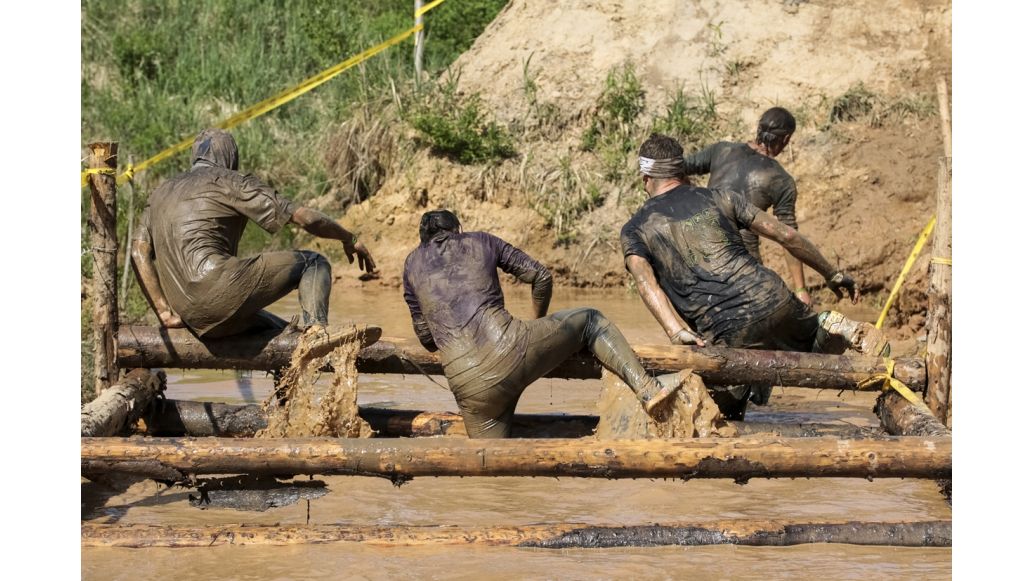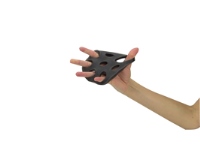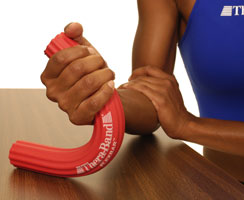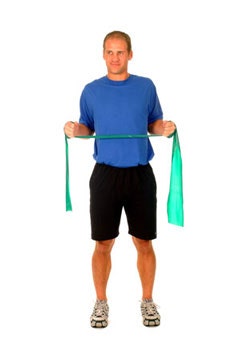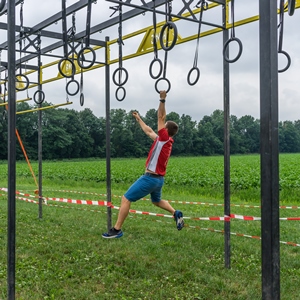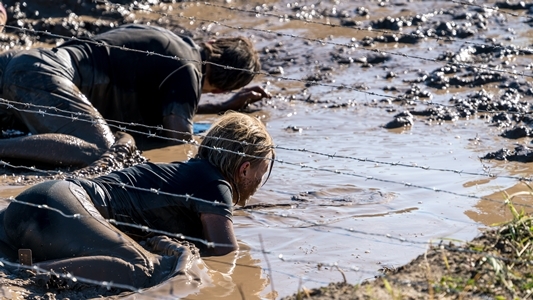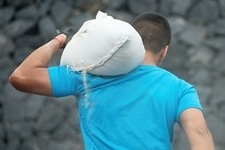4.9 million people participated in obstacle course races worldwide in 2015 and the number continues to grow. That makes them more popular, with more annual participants, than half-marathons and full-marathons combined.
So you know OCRs (obstacle course races) are exploding in popularity. Maybe you’ve seen ads online, a friend just completed a course, or someone has convinced you to sign up. Perhaps you’re looking for a new fitness challenge, something to break up your normal running or cycling routine. These races are fun, challenging, and encourage teamwork.
What are you waiting for? Find out everything you need to know about obstacle course races in this guide.
- Get Started: Training for an Obstacle Course Race
- How long should your training schedule last?
- Training Schedule Changes Week One to Race Day
- What you’ll need: Get a full checklist of everything you’ll need from training to race day!
- How to Tackle Training Aches and Pains
- Tips for Common Obstacles
- Race Day: What to Bring to an OCR
FAQ
What are obstacle course races (OCR)?
- They are races that combine running with a variety of obstacle challenges along the way. They require a mix of cardio and strength skills to complete the course.
Which races are the most popular?
- Spartan Races®, Tough Mudders®, Rugged Maniac®, and Warrior Dash® are all major hosts of obstacle races/challenges, plenty of other companies also hold obstacle races or mud runs (messy, muddy races without the obstacles).
| Race | Signature Obstacle | Vibe |
|---|---|---|
| Spartan Races® | Spear Throw (toss into a target 25 ft away) | Competitive (races are timed) |
| Tough Mudders® | Electroshock Therapy 2.0 (40 ft. jog through live wires) | Teamwork (untimed, work together to finish) |
| Warrior Dash® | Goliath (cargo net crawl to balance beam to waterslide) | Party (prizes for fast finishes, but also best costume and best beard) |
| Rugged Maniac® | Accelerator 3.0 (nearly 80 ft. tall slide) | Social (25 fun obstacles crammed into a 5K course) |
What happens if I need to skip an obstacle or can’t complete it?
- All the races encourage you to only do the obstacles you feel comfortable with. Don’t worry if you need support during an obstacle, runners are encouraged to help each other. You can skip obstacles if you need to and go around them. In timed races, you might need to do penalty exercises like burpees while in untimed races there isn’t usually a penalty.
Are all of the races timed?
- No, it depends on the race. Timed races and challenges (untimed) both have obstacle course options.
Can I participate with a team?
- Yes, teamwork is encouraged in most races. Other teammates can help you get over obstacles and offer encouragement along the way. If you don’t have a team, other runners are usually willing to give you a hand when you need it.
How long should I train for?
- How much time you’ll need for training depends on your beginning fitness level and goals. Most people can finish a course with only basic training, but if you want a competitive time, you’ll need to invest more. Plan on 8-16 weeks of training depending on your skills.
How long is the course?
- The length varies depending on the race, there are several 5Ks (3.1 miles) and track lengths go up from there. Spartan Races® even offers a 26.2 mile marathon obstacle race.
Get Started: Training for an Obstacle Course Race
How long should your training schedule last?
- Novice (couch potato): Can run less than 2 miles, do less than 20 pushups, and can’t do a pull up
- 3-4 workouts a week for 16 weeks
- Intermediate (somewhat athletic): Can run 3 miles, even if you’re exhausted afterwards, do 20 pushups, and at least 1 pull-up
- 3-4 workouts a week for 12 weeks
- Expert (athletic): Can run 6 miles at a moderate pace, do 40 pushups easily, and complete 5 pull-ups
- 3 workouts a week for 8 weeks
Training Schedule Changes Week One to Race Day
- Start running first and add in the strength training gradually
- Increase running by about 10% a week, go slowly and ease off if needed
- Focus on 2-3 strength training sessions a week
- Set a goal halfway through and re-evaluate your schedule as needed
- Add in circuit training later on to prepare your body for the changing loads, mix runs with breaks to do muscular workouts
- Cut back on exercising the week before your race, but don’t skip out entirely

What you’ll need: Get a full checklist of everything you’ll need from training to race day!
Run
On running days you won’t need much. Decide if you want to run on a treadmill, a track, or outside. If you’re new to running or trying out new shoes, wear these foam pads to help prevent painful blisters that could mess up your training schedule. Make sure you have comfortable shoes and consider adding orthotics for extra arch support. While you should focus on running, you can do other cardio activities some days, like biking or jump roping. As you continue training, make sure to spend some time running on hills and uneven terrain to match what you’ll encounter on race day.
Strength Training
Muscular focused workouts help you get in shape for the obstacle portion of your event. In addition to regular weights, kettlebells are a great option for working a lot of muscles at once. You should also use a hand exerciser to build strength in your fingers, it will come in handy when swinging on rings or monkey bars. Pull-ups are another exercise that will help you overcome several obstacles. Use a TheraBand FlexBar to work your other arm muscles like your wrists and forearms.
Exercise Suggestions
|
|
|
Circuit Training
This is an important addition to the schedule because it helps you prepare for race day. Mixing running and strength exercises gets you ready for the changing loads as you run between obstacles. Add in push-ups, mountain climbers, burpees, jump squats and more to your routine. A TheraBand resistance band can be carried while running and pulled out for several exercises or use the TheraBand CLX resistance band for more dynamic exercises. Looking for ideas? Try the exercises below.
Exercise Suggestions
|
|
|
Rest
Make sure you get actual rest on these days. They help you recover and prevent injuries from overtraining. In addition to getting enough sleep, you should do some dynamic stretching. Foam rolling can help relieve any sore or tight muscles. You can still get some exercise by walking or swimming, two activities that put less stress on your body.
How to Tackle Training Aches and Pains
Working out can leave you with sore muscles. Biofreeze Classic is one option to relieve pain fast. It leaves you with a cooling sensation instead. Foam rolling can also help relieve most pain. If it’s in your foot, a foot roller might be a better solution. This one can be chilled for extra relief. Don’t forget blister bandages in your “Feel-Better Kit”. They help protect blisters as they heal. If you have a more serious injury, be sure to see a medical professional and ask them how long you should rest before resuming training.
Tips for Common Obstacles
|
|
|
|
|
Race Day: What to Bring to an OCR
What you’ll need during the race:
Between the obstacles and running, you’ll want to stick to the essentials and keep the rest of your stuff in the car or in a race locker (if they’re available). Consider skipping the sunglasses, hat, and phone as they might get lost or wet.
Apply sunscreen before the race and wear shoes with good drainage and traction to combat any wet, muddy territory. Add blister pads to protect your heels and other sensitive areas on your feet. Your clothes should wick away moisture. Avoid cotton because it takes a long time to dry and can cause chafing. Applying Cramer Skin Lube can help reduce chafing while running.
Protect your skin with additions like knee and elbow pads. Gloves not only offer protection, but also enhance your grip on slippery obstacles. Kinesiology tape can help support your muscles during the race. TheraBand tape stays in place even when wet and can hold up throughout the course. If it’s a longer race, consider using a hydration pack to carry water with you. Running in the winter? Add hand warmers to keep your fingers toasty.
What you’ll need after the race:
Start by gathering everything you’ll need for the clean-up. Many races offer showers or hoses to rinse off the mud. If they don’t, or you want to clean up faster, bring baby wipes. They’re also great to wipe off your hands before you take a post-race selfie.
Towels are a must-have. You can use one to wash up, dry off, or change behind. Or place it on your car seat to keep it clean when travelling back home. They can also double as a blanket to keep you warm from pre-race chills.
You’ll also need garbage bags to hold all of your wet, muddy clothes and shoes on the way home and a complete change of clothes and shoes to change into. Some people prefer flip-flops to let their feet dry. Double bag it to make sure nothing leaks out in your car.
Be prepared to tend to any minor wounds by carrying a first aid kit with all of the basics including bandages, antiseptic wipes, tape, and more. Relieve sore muscles by tossing Biofreeze in your race bag. A portable massage roller can also help relieve painful or tight muscles.
Bring money and a credit card to buy post-race snacks, drinks, and gear. Or avoid the lines by bringing your own snacks and a full water bottle. Some races sell alcohol afterwards, don’t forget your ID if you want a drink and are of legal age.
So you made it across the finish line and you’re willing and crazy enough to race again? Make sure you save this guide for reference during any of your future obstacle course race preparations.
References
Obstacle Race World. Obstacle Course Races and Mud Runs: A Complete Guide to the Business…and More. (n.d.). Retrieved from https://bit.ly/2KQUJXX
Perez, A.J. (2015). Obstacle races going mainstream, more popular than marathons. Retrieved from https://usat.ly/2KLBJ05
Medical Disclaimer: The information provided on this site, including text, graphics, images and other material, are for informational purposes only and are not intended to substitute for professional medical advice, diagnosis or treatment. Always seek the advice of your physician or other healthcare professional with any questions or concerns you may have regarding your condition.

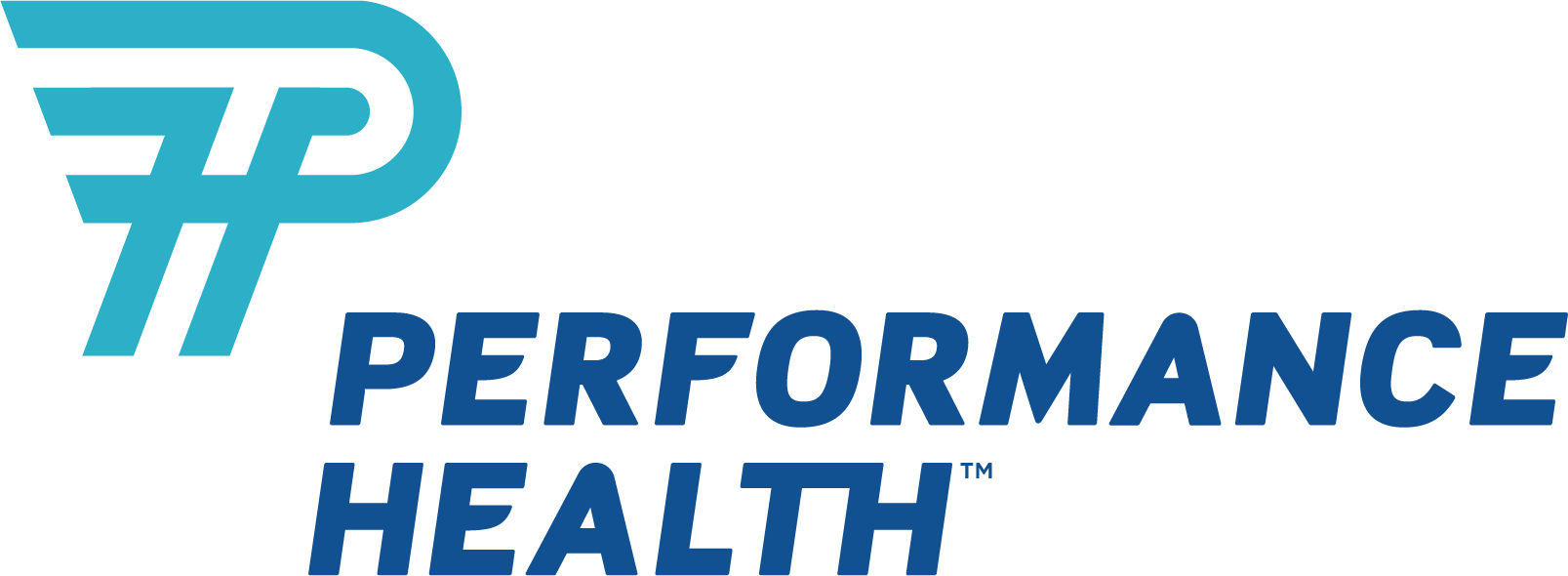






 France
France Australia
Australia